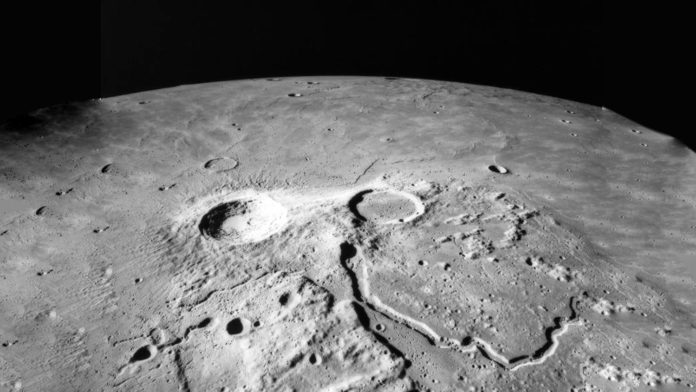Water ice deposits exist at the lunar poles, where temperatures are low enough for these deposits to remain stable over long timescales. However, water ice’s origin, abundance, and distribution remain poorly understood. One potential water source is the volcanism on the moon, having occured about billions of years ago.
A new study from CU Boulder investigates whether volcanic outgassing is a viable source for accumulating lunar polar water ice. Scientists found that the lunar volcanism may have left a lasting impact on the lunar surface: Ice sheets dot the moon’s poles. These sheets are dozens or even hundreds of feet thick in some places.
Scientists constructed a model to recreate conditions on the moon long before complex life arose on Earth. The model suggested that ancient volcanic eruptions on the moon spewed huge amounts of water vapor. These water vapors are then settled onto the lunar surface- forming stores of ice that may still be hiding in lunar craters.
Study co-author Paul Hayne said, “It’s a potential bounty for future moon explorers who will need water to drink and process into rocket fuel. It’s possible that you have big sheets of ice 5 or 10 meters below the surface.”
According to scientists, the moon was a chaotic place almost 2 to 4 billion years ago. Several volcanoes erupted across its surface during this period, generating huge rivers and lakes of lava.
Hayne said, “They dwarf almost all of the eruptions on Earth.”
According to a recent study from the Lunar and Planetary Institute in Houston, these volcanoes are also believed to have expelled massive clouds of carbon monoxide and water vapor. These clouds then swirled around the moon, possibly forming thin, transient atmospheres.
This wondered scientists: Could that same atmosphere have left the ice on the lunar surface, like frost forming on the ground after a chilly fall night?
To find the answer, scientists set out to try to put themselves onto the surface of the moon billions of years ago. They used estimates that, at its peak, the moon experienced one eruption every 22,000 years, on average. They then explored how volcanic gases may have swirled around the moon, escaping into space over time. And, they discovered, conditions may have gotten icy.
The model suggests that roughly 41% of the water that erupted over this period could have condensed as ice in the polar regions, with thicknesses up to several hundreds of meters.
Andrew Wilcoski, a lead author of the new study and a graduate student in the Department of Astrophysical and Planetary Sciences (APS), said, “The atmospheres escaped over about 1,000 years, so there was plenty of time for ice to form.”
There may have been so much ice on the moon that you could, conceivably, have spotted the sheen of frost and thick, polar ice caps from Earth. The group calculated that about 18 quadrillion pounds of volcanic water could have condensed as ice. That’s more water than currently sits in Lake Michigan. And the research suggests that much of that lunar water may still be present today.
However, finding those ice cubes is not an easy task. Most of them likely accumulated near the moon’s poles and may be buried under several feet of lunar dust or regolith.
Wilcoski said, “We really need to drill down and look for it.”
Journal Reference:
- Andrew X. Wilcoski et al 2022 Planet. Sci. J. 3 99. Polar Ice Accumulation from Volcanically Induced Transient Atmospheres on the Moon. DOI: 10.3847/PSJ/ac649c
